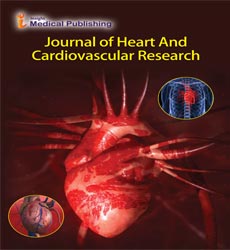ISSN : ISSN: 2576-1455
Journal of Heart and Cardiovascular Research
How Aortic Valve Fix Practically Conceivable.
Jhump James*
Department of Surgery, The University of Mostaganem, Algeria, Africa
- *Corresponding Author:
- Jhump James
Department of Surgery, The University of Mostaganem, Algeria, Africa
E-mail:jumpjames@list.af
Received Date: August 16, 2021; Accepted Date: November 17, 2021; Published Date: November 29,2021
Citation: James J (2021) How Aortic Valve Fix Practically Conceivable, J Heart Cardiovasc Res, Vol:5 No:6.
Editorial
Aortic valve fix or aortic valve remaking is the reproduction of both structure and capacity of a useless aortic valve. Most often it is utilized for the treatment of aortic regurgitation. It can likewise become important for the treatment of aortic aneurysm, less habitually for inherent aortic stenosis.
An aortic valve fix will practically be conceivable without calcification or contracting (withdrawal) of the aortic valve. Consequently, intrinsic aortic stenosis might be treated by aortic valve repair. In obtained aortic stenosis valve substitution will be the lone sensible choice. In many occurrences, aortic valve fix will be performed for aortic spewing forth (insufficiency).Aortic valve fix may likewise be acted in the treatment of aortic aneurysm or aortic analyzation if either aneurysm or analyzation includes the aorta near the valve.
The objective of the activity is the improvement of future and treatment of cardiovascular breakdown as the result of brokenness of the aortic valve. The objective may likewise be to turn away complexities of the aorta in the treatment of aneurysm. Fix is a later option in contrast to substitution; in many examples substitution will be the solitary reasonable alternative in light of serious annihilation of the valve.
While substitution of the aortic valve is a protected and reproducible strategy it might in any case be related with the drawn out event of alleged valve-related difficulties. The likelihood of these difficulties relies upon the age of the patient and the kind of operation. Typical intricacies are blood cluster arrangement on the valve or dislodgment of clots (embolism); draining inconveniences are normally a result of "blood-diminishing" prescription expected to forestall clumps (anticoagulation). Biologic/tissue substitution valves tend to decline, and there is additionally an expanded danger of contaminations of valve prosthesis (prosthetic valve endocarditis).
Contrasted with the consequences of valve substitution there will be an insignificant propensity towards cluster development after aortic valve fix, and anticoagulation is ordinarily excessive, accordingly limiting the chance of draining confusions. The probability of disease of the fixed aortic valve is a lot of lower contrasted with what is seen after aortic valve replacement. A maintenance technique may not keep going forever, but rather in many occasions the solidness of an aortic valve fix will particularly surpass that of an organic prosthesis.
The subtleties of the aortic valve fix technique rely upon the chance of inborn contortion of the valve, the sort and level of optional disfigurement, and the presence of an aortic aneurysm. The objective of the method is the reclamation of a typical type of the aortic valve, which will then, at that point lead to approach ordinary capacity and great solidness of the maintenance. A transesophageal echocardiogram during the activity and preceding the maintenance will be essential to characterize the specific misshapening of the aortic valve and along these lines the system of regurgitation.[citation needed]
To best oblige the intricate math of the aortic valve, these methodology are for the most part performed through open-heart medical procedure. Insignificantly obtrusive methodology limit the capacity to definitely pass judgment on the type of the aortic valve and will prompt a higher vulnerability with respect to capacity and toughness of aortic valve fix. Concerning aortic valve substitution, the heart-lung machine is generally associated with the patient through aorta and right chamber. The heart is captured through cardioplegia, and the type of the aortic valve is painstakingly investigated. Right now archived anticipated qualities for specific parts of the type of the aortic valve are accessible. Utilizing these boundaries and a decent transesophageal echocardiogram the exact system of spewing forth still up in the air in most cases.
Open Access Journals
- Aquaculture & Veterinary Science
- Chemistry & Chemical Sciences
- Clinical Sciences
- Engineering
- General Science
- Genetics & Molecular Biology
- Health Care & Nursing
- Immunology & Microbiology
- Materials Science
- Mathematics & Physics
- Medical Sciences
- Neurology & Psychiatry
- Oncology & Cancer Science
- Pharmaceutical Sciences
